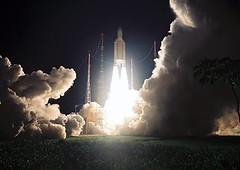
France has launched a new spy satellite from its Caribbean colony of Guiana. Unrest in the Caribbean possessions earlier in the year prompted the dispatching of hundreds of riot police.
Originally uploaded by Pan-African News Wire File Photos
By Franck Leconte
CAYENNE, French Guiana (Reuters) - France launched a military spy satellite on Friday, space officials said, part of a boost in spending on independent surveillance.
It was the first such launch under President Nicolas Sarkozy, who brought France back into NATO's military command earlier this year after a four-decade hiatus.
While cooperating more closely with the United States on military planning, France sees independent access to space intelligence as a strategic priority.
The satellite, Helios 2B, blasted off on a European Ariane rocket at 1626 GMT from the European Space Agency launch site in Kourou, French Guiana, on the northeast coast of South America.
It was separated from the Ariane rocket 59 minutes later.
Initially scheduled for launch on Dec. 9, countdown was halted several hours before the lift-off when a technical problem in the rocket's helium subsystem was detected.
A second attempt to launch the satellite was halted on Thursday five minutes before blast-off.
"The first mission of these tools is to assure France's independent analysis by having the independent means of acquiring intelligence worldwide," Lieutenant Colonel Christophe Morand, head of the Helios programme of the French military command, told a briefing in Kourou before last week's aborted launch.
"We must be able to furnish the (French) president with proof during a conflict that a country has violated another country's national sovereignty," Morand said.
BETTER INTELLIGENCE
Helios 2B is the second of France's new generation "spy in the sky" series manufactured by the space division of Airbus parent EADS. Its predecessor was launched in 2004.
Earlier generation Helios 1 satellites launched aboard Ariane rockets in 1995 and 1999 were less sophisticated.
Defence officials said Helios 2's infra-red system permits detection of human activity. They said it can tell whether a truck convoy is moving or halted and whether a nuclear reactor is operational or not.
It will be capable of operating at night but will not be able to capture images through clouds.
The satellite would help in preparing missions and assessing threats, as well as drawing up maps of uncharted zones in Afghanistan, Iraq, Chad and the Sudanese region of Darfur.
Defence officials said full disclosure of the satellite's capacity could not be made public.
Helios was initially planned as a pan-European satellite series to counter U.S. space intelligence domination during the Cold War. However, France's European partners have been less willing to participate financially in the Helios 2 programme.
The 1990s first generation Helios 1 programme attracted contributions totalling 21 percent from Spain and Italy. But France has financed 90 percent of the 2 billion euro ($3 billion) Helios 2 series with Italy, Belgium, Spain and Greece contributing 10 percent.
(Additional reporting and writing by Alexander Miles)
No comments:
Post a Comment